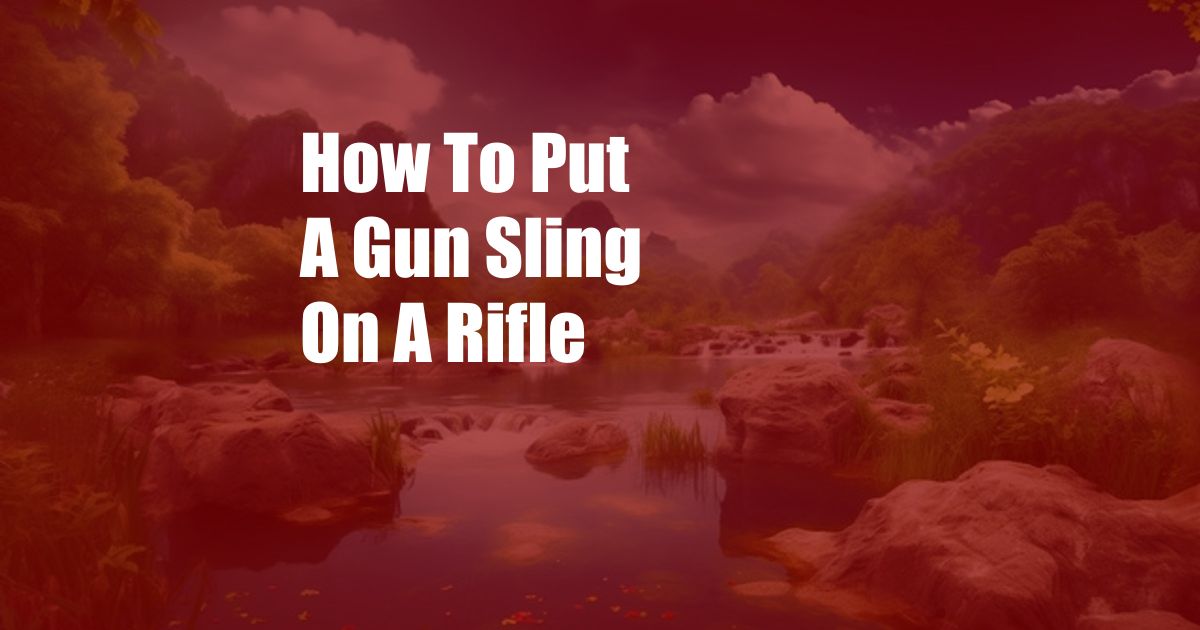
How to Install a Sling on Your Rifle for Enhanced Convenience and Control
As an avid hunter, I’ve always valued the importance of having a reliable and comfortable sling on my rifle. It allows for effortless carrying, quick access, and improved stability when taking shots. Installing a gun sling is a relatively simple task that can significantly enhance your shooting experience, whether you’re a seasoned hunter or a beginner.
In this comprehensive guide, we’ll delve into the intricacies of sling installation, exploring the types of slings, materials, and techniques involved. We’ll also provide expert tips and advice to ensure you achieve a secure and ergonomic fit.
Choosing the Right Sling
The first step in installing a gun sling is choosing the right one for your rifle and shooting preferences. Slings come in a variety of styles and materials, each offering unique advantages and drawbacks.
**Single-Point Slings:** These slings attach to a single point on the rifle, typically the rear sling swivel. They provide quick access to the rifle and allow for easy maneuvering. However, they offer less stability compared to two-point slings.
**Two-Point Slings:** As the name suggests, two-point slings attach to two points on the rifle, usually the front and rear sling swivels. They offer improved stability and weight distribution, making them a popular choice for hunting and tactical applications.
**Three-Point Slings:** Three-point slings feature an additional attachment point that connects to the rifle’s stock. They provide maximum stability and can be quickly adjusted for different shooting positions.
Materials
Slings are typically made from a variety of materials, including leather, nylon, and neoprene. Each material has its own set of properties:
**Leather:** Leather slings are durable, stylish, and provide a classic look. However, they can be more expensive and require regular maintenance to prevent cracking.
**Nylon:** Nylon slings are lightweight, strong, and water-resistant. They are a popular choice for tactical applications due to their durability and low-profile design.
**Neoprene:** Neoprene slings are soft, comfortable, and provide good insulation. They are a suitable option for hunting in cold weather or for shooters with sensitive shoulders.
Installation Techniques
Installing a gun sling is relatively straightforward. Here are the general steps involved:
- Identify the sling swivels on your rifle. These are usually located at the front and rear of the stock.
- Attach one end of the sling to the front sling swivel using a sling swivel stud or QD (quick detach) mount.
- Adjust the length of the sling so that it fits comfortably over your shoulder when the rifle is slung.
- Attach the other end of the sling to the rear sling swivel using the same method.
- Tighten all screws and check the security of the sling.
Tips and Expert Advice
Here are some additional tips to ensure a secure and ergonomic sling installation:
- Choose a sling that is compatible with your rifle’s sling swivels and attachment points.
- Make sure the sling is the right length for your height and shooting style.
- Properly tighten all screws and fittings to prevent the sling from slipping or loosening.
- Consider using a sling swivel stud adapter if your rifle does not have built-in sling swivels.
- For added stability, you can attach a bipod to the front sling swivel.
Frequently Asked Questions (FAQs)
Q: Can I install a sling on any rifle?
A: Most rifles can be equipped with a sling. However, some models may require the use of a sling swivel stud adapter.
Q: What is the best material for a gun sling?
A: The best material depends on your preferences and shooting style. Leather slings are durable and stylish, while nylon slings are lightweight and strong. Neoprene slings offer comfort and insulation.
Q: How do I adjust the length of my sling?
A: Most slings have adjustable buckles or sliders that allow you to customize the length. Adjust the sling so that it fits comfortably over your shoulder when the rifle is slung.
Conclusion
Installing a gun sling on your rifle is a crucial step for enhancing your shooting experience. By choosing the right sling, using the appropriate installation techniques, and following our tips and expert advice, you can ensure a secure and ergonomic fit. Whether you’re a seasoned hunter or a beginner, a well-installed sling will provide effortless carrying, quick access, and improved stability, allowing you to focus on your target and make every shot count.
Are you interested in learning more about gun slings or other rifle accessories? Leave a comment below and let us know.